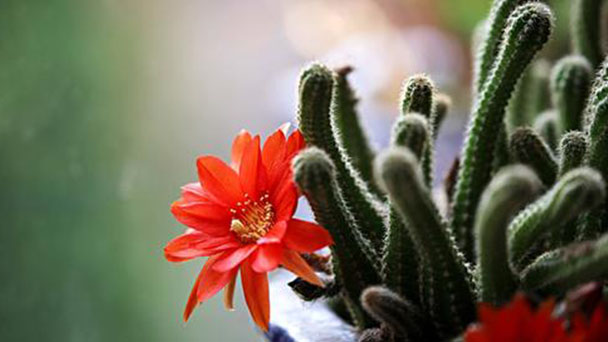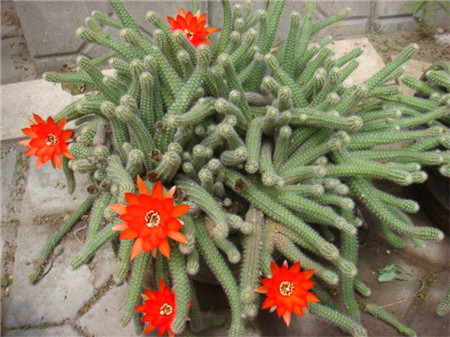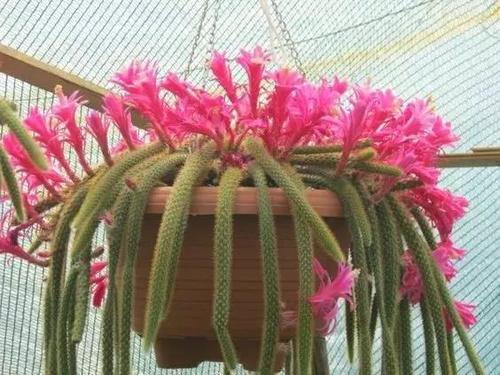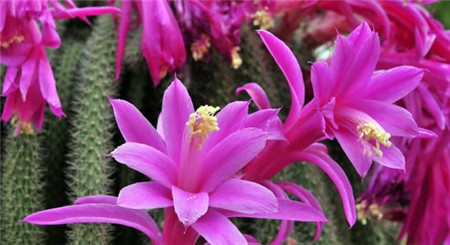Rattail cactus profile
Written by Maggie
Feb 05 2021

Rattail Cactus, scientific name Aporocactus flagelliformis, has an elongated, creeping, branching stem up to 2 m long, bright green when young and grayish green later. Rattail Cactus has hallow ribs 10-14, radiating prickles 10-20, new prickles red, later turning yellow to brown. Flowers bloom in spring, the flowers are bilaterally symmetrical, pink, open during the day and closed at night. Berry is globular, red. Rattail Cactus is pleasant at drainage, good ventilation of fertile soil, can be used with leaf rot soil, sand and loam, etc. Rattail Cactus like full sunshine. The overwintering temperature needs to be above 10℃.
Rattail cactus picture

Growth habits of rattail cactus
Rattail Cactus (Aporocactus flagelliformis) is a common Cactus plant used as an ornamental plant. rattail cactus (Aporocactus flagelliformis) likes a sunny environment and needs to keep its temperature high. In winter, the overwintering temperature should be kept above 10℃. Soil is generally good drainage and air permeability of the soil can be mixed with leaf rot soil and sand production.
Rattail cactus growing method
1. The soil
Rattail Cactus (Aporocactus flagelliformis) prefers fertile soil that drains well and breathes well. It can be mixed with leaf rot, sand, etc.
2. Temperature and light
Rattail Cactus (Aporocactus flagelliformis) likes to grow in warm conditions and can tolerate shade. The temperature of overwintering should be above 10 degrees Celsius, and it should be timely into the room, placed in a sunny place indoors, and the indoor temperature should not be less than 10 degrees Celsius, after the Tomb Sweeping Festival. In summer to maintain ventilation, to the outdoor breeding. Pay attention to shading and cooling.
3. Water
Avoid getting caught in the rain, or your roots will rot. In summer, a certain amount of humidity should be maintained to avoid long-term dryness, which is not conducive to the growth of Rattail Cactus (Aporocactus flagelliformis). Winter to keep relatively dry, control watering, to do not pour, pouring is pouring thoroughly as a principle. The soil does not easily get too wet. Reduce the amount of watering after buds appear to avoid buds falling. The growing period should often spray moisture, increase the humidity of indoor air. Fertilization at Rattail Cactus applies liquid fertilizer twice a week, mainly organic fertilizer, and does not apply fertilizer in winter and summer.
4. Disease and insect pest prevention
Rattail Cactus (Aporocactus flagelliformis) is vulnerable to red spider disease, which is usually yellowish-brown and can be prevented by spraying diethoate.
5. The basin
Rattail Cactus (Aporocactus flagelliformis) is repotted twice a year, after flowering, or a larger pot if the roots have grown in one. Rattail Cactus prefers fertile soil that drains well and breathes well. It can be made with a mixture of leaf rot, sand, etc.

Rattail Cactus propagation Method
1. Grafting period of Rattail Cactus
The best time for Rattail Cactus (Aporocactus flagelliformis) grafting is in spring when the growth of Rattail Cactus is relatively strong and the wounds left by grafting can heal quickly. Therefore, spring is the best time for grafting.
2. Selection of grafting rootstocks of Rattail Cactus
Rattail Cactus can be grafted stock choices of straight column Cactus to compensate for the lack of creeping growth, such as large flower snake whip post or pear Cactus.
3. Grafting steps of Rattail Cactus
Select the top of the metamorphosis stem of Rattail Cactus (Aporocactus flagelliformis), cut about eight to ten centimeters of scion and attach it to the selected stock. Generally, the wound will heal in two to three months.
4. Maintenance of Rattail Cactus after grafting
After grafting, attention should be paid to ventilation and adequate sunlight. Summer can not be exposed to the sun, the winter should pay attention to heat preservation, keep its living temperature above 10 degrees Celsius.
The main value of rattail cactus
Rattail Cactus (Aporocactus flagelliformis) is a good indoor flower, suitable for home potted windowsills, can also be hung hanging basket cultivation.

Latest Updated
- Benefits of Bugleweed - 7 Science-backed Health Benefits
- Bugleweed Dangers & Side Effects - Is It Poisonous?
- How to Plant Evergreen Trees - What You Should Know
- When to Plant Evergreens - Grow Guide for Evergreen Trees
- 12 Wonderful Evergreen Shrubs for Your Garden
- 12 Popular Evergreen Plants with Pictures for Beginners
- When And How To Prune A Lilac Bush Like a Pro
- How to Grow & Care for Lilac Vine (Hardenbergia Violacea)
- Japanese Lilac Tree (Syringa Reticulata) Care & Propagation Guide
- Shumard Oak Pros and Cons - What to Know
Popular Articles
- Winter maintenance of Antirrhinum Majus
- How to Grow Terminalia Mantaly Tree
- How to Grow and Care for Crossostephium Chinense
- How to grow Antirrhinum Majus in spring
- Peristeria Elata (Dove Orchid) Profile: Info & Care Guide
- Underwatered Snake Plant (Sansevieria Trifasciata) - Signs And How To Fix
- How to Care for Brazilian Jasmine Plant (Mandevilla Sanderi)
- How to Grow & Care for Graptopetalum Purple Delight in Summer
- Rosa Chinensis (China Rose): Plant Growing & Care Tips
- How to Care for Baby Sun Rose (Aptenia Cordifolia)